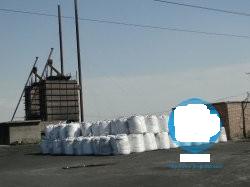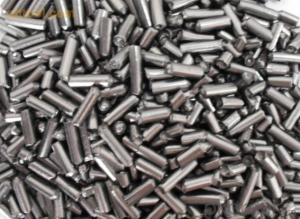Carbon Aditive 90%min
- Loading Port:
- China Main Port
- Payment Terms:
- TT OR LC
- Min Order Qty:
- -
- Supply Capability:
- -
OKorder Service Pledge
OKorder Financial Service
You Might Also Like
1.Features:
Carbon Additive also called Calcined anthracite Coal, Gas Calcined Anthracite Coal, Carbon Raiser.
The main raw material is Ningxia unique high quality anthracite, with characteristic of low ash and low sulfur. Carbon additive has two main uses, namely as the fuel and additive. When being used as the carbon additive of steel-smelting, and casting, the fixed carbon may achieve above 95%.
2.Application:
It may substitute massively refinery coke or the stone grinds. Meanwhile its cost is much less than the refinery coke and the stone grinds. Carbon Additive may also use as the fuel, for its calorific value may achieve above 9386K/KG. It may substitute burnt carbon massively. The burnt carbon exportation needs the quota; therefore the carburizing agent price superiority is similarly obvious.
3.Specifications:Chemical Composition(%) | ||||
F.C. | Ash | V.M. | S | Moisture |
%(min) | %(max) | |||
90 | 8.5 | 1.5 | 0.35 | 1.0 |
0.5-3mm, 1-4mm,0.5-4mm,1-3mm, 90%min,or at customer’s option; | ||||
In 1000kgs big bag; or 1200kgs big bag; or 25kgs small bag, then into 1000kgs big bag; or 25kgs or 50kgs small bag, then put into containers directly;or at customer’s option;
| ||||
- Q: Are carbon fibers organic polymer materials?
- Molecular inorganic macromolecular substance may be from a variety of other elements of atoms. The backbone composed entirely of the same element called "backbone chain", composed of different kinds of elements called impurity atoms in the main chain chain. Mainly by covalent bond between atoms (including coordination bond) combined with each other.Carbon fiber (carbon fiber, referred to as CF), is a new type of fiber material with high strength and high modulus fiber in more than 95% of a carbon content. It is composed of flake graphite microcrystalline fibers along the fiber direction of piling up, Shi Mocai ceramics material by carbonization and graphitization treatment the microstructure of carbon.
- Q: What do you stand for?Tar, smoke, nicotine, and carbon monoxide. What do you mean? What's the size of the smoke, or the size of the smoke? What's the connection? Smoking is harmful, so how do you choose to smoke smaller cigarettes?
- Compared with the 1mg now, but the taste of light to you simply don't get things, unable to meet the physiological needs, will be more big. So the deep harm than simple 5mg smoke into the lungs and then exhale.Just feel well enough on the line. This was something very mysterious, you can go to a professional ask smoking community. Um. Provide a product Baidu search on it. Is a product tasting tea smoke forum.
- Q: Appearance, hardness, electrical conductivity, use of carbon 60
- C60 does not normally conduct electricity because C60 is so large that it can put other atoms into it and affect its physical properties, so it cannot be electrically conductiveUsed to strengthen metalImprove the metal material strength by alloying, plastic deformation and heat treatment, one of the ways to strengthen the interaction through geometry, such as coke carbon dispersed in the metal, carbon and metal exchange position in the crystal lattice, can cause plastic deformation of metal, carbon and metal carbide particles that can make the metal enhanced. In the enhancement of metal materials, the effect of C60 ratio of carbon in coke is better, this is because the C60 is higher than the smaller particles, active carbon, particle size of C60 with metal carbide dispersion effect is 0.7nm, and the particle size of carbon and metal carbide dispersion effect the body is 2 m ~ 5 m, has a larger difference in enhancing the role of the metal.Used as a new catalystIn C60, the electronic structure of chemists began to explore the possibility of.C60 catalyst for C60 with olefin, with transition metal (such as platinum and nickel metal) to form a series of complexes. For example C60 and platinum, osmium can be combined into {[(C2H5) 3P]2Pt}C60 and C60OsO4 (four butylpyridine) and other coordination compounds and they are likely to become the efficient catalyst.Japanese researchers Toyohashi University of science and technology of the synthesis of highly catalytic activity of palladium Pt synthesis researchers and C60 compound C60Pd6. China Wuhan University (PPh3) 2C60 (PPh3 three, triphenylphosphine) for hydrosilylation reaction with high catalytic activity.
- Q: What materials can be carbonitriding?
- Low temperature carbonitriding for high alloy tool steel, high-speed steel tools, etc., in temperature carbonitriding is under great pressure not only in carbon steel wear parts, high temperature carbonitriding is mainly used for medium carbon steel and alloy steel under great pressure.
- Q: Is the power consumption of carbon fiber heating very high?
- Power consumption calculation:The information you give is not enough to calculate the approximate power consumption!You also need to know your building structure, insulation level, the laying power of electric heating, personal use, setting temperature, local temperature difference between indoor and outdoor, control device is intelligent temperature control and so on!There is also the first heating season, because the building is humid, the electricity consumption will be higher!How to save electric energyIf you want to save electricity, you need it:Give the building a good heat insulation,Use double or three layers of glass,Intelligent temperature controller, and according to the rules of personal life to set, make full use of energy saving, and these are not to reduce somatosensory comfort conditions,The carbon fiber heating cable laying and electric heating, far infrared ray to human body temperature will be higher, also need 18 degrees of comfort, the use of carbon fiber electric heating heating cable only need to set at 16 degrees, so the temperature can be, 2 DEG C, and the temperature difference is small at the only Province 2 C energy, in fact is not the case, as we all know, small temperature difference, the indoor temperature is more easy to maintain!Apply the peak and valley tariff to the local electricity department, so that the electricity price will be around 0.35 yuan at night, and the temperature will be greater at home and in the evening, which will save a lot of money!Do all of this and I'm sure you'll save 20% of your electricity bill!Poly Jiao carbon fiber heating cable electric heating - for you, we are more professional
- Q: How does carbon impact the prevalence of ocean acidification?
- Carbon impacts the prevalence of ocean acidification primarily through the process of carbon dioxide (CO2) absorption by seawater. Increased levels of atmospheric CO2, mainly caused by human activities such as burning fossil fuels and deforestation, lead to more CO2 being dissolved in the oceans. This excess CO2 reacts with seawater to form carbonic acid, which lowers the pH of the ocean and increases its acidity. This increased acidity has detrimental effects on marine life, particularly organisms with calcium carbonate shells or skeletons, as it hampers their ability to build and maintain their structures. Overall, the high levels of carbon in the atmosphere contribute to ocean acidification, which poses significant threats to marine ecosystems and biodiversity.
- Q: How does carbon impact ocean acidity?
- Carbon impacts ocean acidity through a process called ocean acidification. When carbon dioxide (CO2) from human activities is emitted into the atmosphere, a significant portion of it is absorbed by the ocean. Once in the ocean, CO2 reacts with water to form carbonic acid, which lowers the pH of seawater, making it more acidic. This increased acidity can have detrimental effects on marine life, particularly on shell-forming organisms like corals, mollusks, and some plankton, as it hampers their ability to build and maintain their calcium carbonate structures. Additionally, ocean acidification disrupts the delicate balance of marine ecosystems, affecting various species and ultimately impacting the entire food chain.
- Q: How do you stick carbon fabric?
- 6, maintenance(1) after sticking the carbon fiber cloth, it is necessary to conserve 24h naturally to reach initial curing, and ensure that the curing period is free from interference(2) before each process, the resin should be covered with plastic film before it is cured so as to prevent sand or rain from attacking(3) when the temperature of the resin curing is reduced to less than 5 degrees, low temperature curing resin can be adopted, or effective heating measures can be adopted(4) CFRP after natural curing required to meet the design strength of time: the average temperature is 10 DEG C, 2 weeks; the average temperature is 10 degrees centigrade above 20 DEG C, 1 to 2 weeks; the average temperature is higher than 20 degrees in 1 weeks. During this period should be to prevent the patch part by the hard impact.7. PaintingThe coating shall be done after the initial curing of the resin and shall comply with the relevant standards and construction requirements for the coating used
- Q: What are the advantages of carbon-based fuel cells?
- Carbon-based fuel cells offer several advantages that make them a promising technology for the future. Firstly, they have a higher energy density compared to conventional batteries, meaning they can store and deliver more energy per unit weight. This allows for longer operating times and greater power output, which is particularly beneficial in applications requiring high power density and long-range capabilities, like electric vehicles. Secondly, carbon-based fuel cells boast a faster refueling time than conventional batteries. While it can take hours to recharge a battery, refueling a carbon-based fuel cell can be done in a matter of minutes. This significant advantage reduces refueling downtime and enables more convenient and efficient usage of the technology. Furthermore, carbon-based fuel cells have a lower environmental impact compared to traditional combustion engines. They produce only water and heat as byproducts, making them clean and environmentally friendly. This is in contrast to internal combustion engines that emit harmful pollutants contributing to air pollution and climate change. Another advantage of carbon-based fuel cells is their versatility and compatibility with existing infrastructure. They can easily be integrated into current energy systems, facilitating a smooth transition from fossil fuels to cleaner energy sources. This compatibility makes carbon-based fuel cells a viable option for various applications, from portable electronics to residential power generation. Lastly, carbon-based fuel cells have the potential to contribute to energy independence. As carbon-based fuels can be derived from renewable sources like biomass or waste, they offer a sustainable and domestically sourced energy solution. This reduces dependence on foreign oil and enhances energy security for countries. In conclusion, the benefits of carbon-based fuel cells include higher energy density, faster refueling time, lower environmental impact, compatibility with existing infrastructure, and the potential for energy independence. With these advantages, carbon-based fuel cells have the potential to revolutionize the energy landscape and provide a sustainable and efficient alternative to conventional energy sources.
- Q: How is carbon used in the production of construction materials?
- Carbon is used in the production of construction materials through a process called carbonization, where organic materials such as wood, coconut shells, or coal are heated to high temperatures in the absence of oxygen. This results in the removal of other elements and the production of carbon-rich materials like activated carbon or charcoal, which can be used in various construction applications such as concrete production, filtration systems, or as a component in composite materials.
Send your message to us
Carbon Aditive 90%min
- Loading Port:
- China Main Port
- Payment Terms:
- TT OR LC
- Min Order Qty:
- -
- Supply Capability:
- -
OKorder Service Pledge
OKorder Financial Service
Similar products
Hot products
Hot Searches
Related keywords























